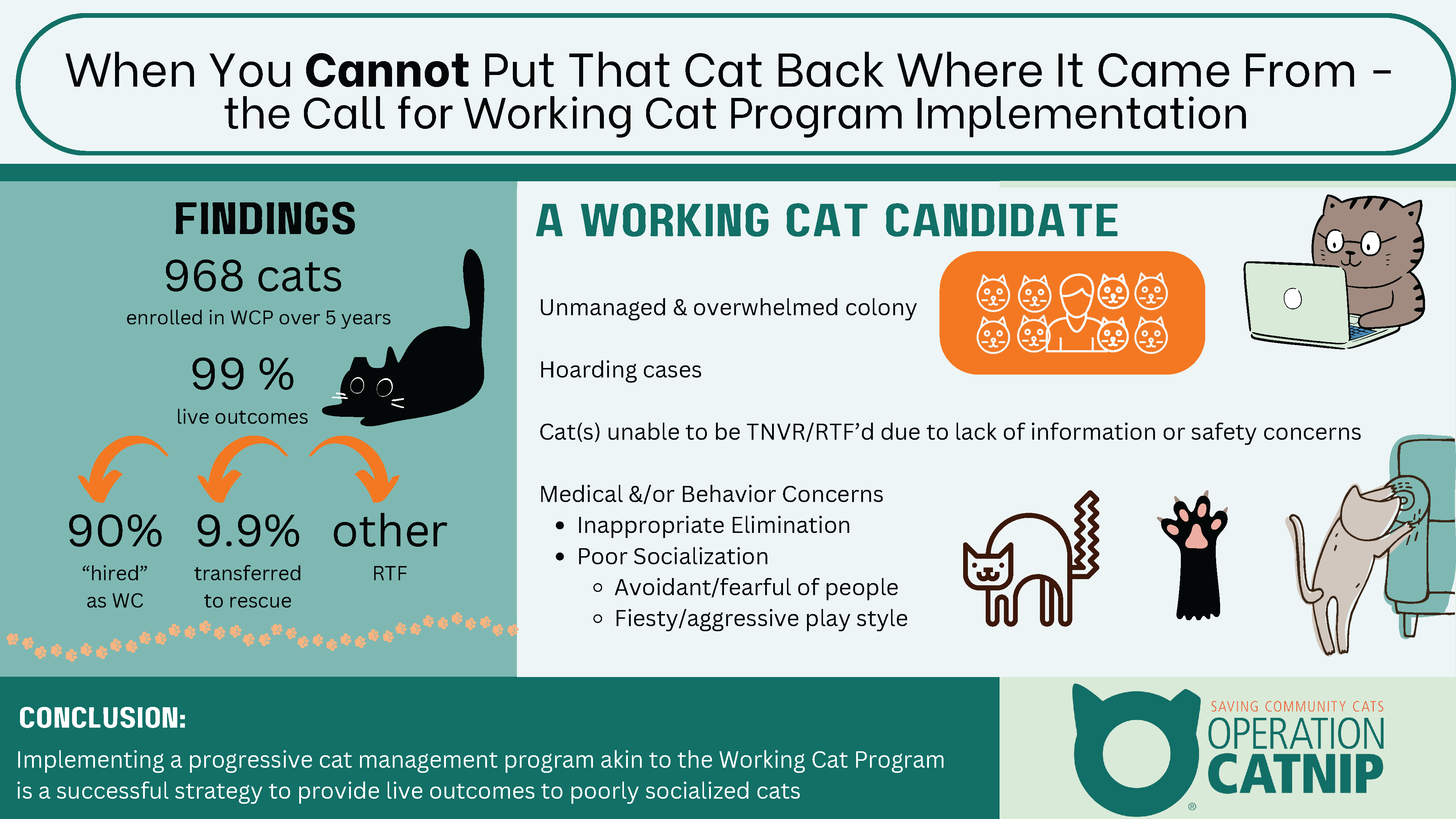When You Cannot Put That Cat Back Where It Came From – The Call for a ‘Working Cat Program’ Implementation
DOI:
https://doi.org/10.56771/jsmcah.v3.89Keywords:
pet overpopulation, shelter medicine, cat relinquishment, euthanasia, feral cats, community cats, fearful catsAbstract
Introduction: Operation Catnip’s (OC) Working Cat Program (WCP) was created to contribute to life-saving efforts for poorly socialized unowned cats that cannot return to their original location and in turn relocation needs to be implemented. The goal of this study was to evaluate the OC’s WCP, a cat management program, conducted in Florida from January 1, 2019, to December 1, 2023.
Methods: Data from cats enrolled in the OC’s WCP were retrieved from electronic records and analyzed using descriptive statistics. Cat adopters were surveyed to assess satisfaction with their adoptions and to evaluate the broader outcomes of the program.
Results: A total of 968 cats were enrolled in 5 years of the program. In total, 99% (n = 959) of the cats had a live release rate (959), where 90% (862) were ‘hired’ (adopted into non-traditional homes), 9.9% (95) were transferred to rescue groups (to be adopted into traditional homes), and 2 were returned to their original location (return to field). 85% of the adopters who responded to a post-adoption survey (329/387) were very or completely satisfied with their adopted cat’s performance, and only 10% (40/387) were not or were somewhat satisfied with their adopted cat’s performance.
Conclusion: Implementing cat management programs like OC’s WCP is a viable and successful way to provide positive live outcomes to cats unsuitable for traditional adoption, as an alternative to euthanasia.
Downloads
References
Boone JD, Miller PS, Briggs JR, et al. A long-term lens: cumulative impacts of free-roaming cat management strategy and intensity on preventable cat mortalities. Front Vet Sci. 2019;6:238. doi: 10.3389/fvets.2019.00238
Halls V, Bessant C. Managing cat populations based on an understanding of cat lifestyle and population dynamics. J Shelter Med Community Anim Health. 2023;2(S2). doi: 10.56771/jsmcah.v2.58
Spehar DD, Wolf PJ. Back to school: an updated evaluation of the effectiveness of a long-term trap-neuter-return program on a university’s free-roaming cat population. Anim Open Access J MDPI. 2019;9(10):768. doi: 10.3390/ani9100768
Levy JK, Isaza NM, Scott KC. Effect of high-impact targeted trap-neuter-return and adoption of community cats on cat intake to a shelter. Vet J Lond Engl 1997. 2014;201(3):269–274. doi: 10.1016/j.tvjl.2014.05.001
Zito S, Aguilar G, Vigeant S, Dale A. Assessment of a targeted trap-neuter-return pilot study in Auckland, New Zealand. Anim Open Access J MDPI. 2018;8(5):73. doi: 10.3390/ani8050073
Operation Catnip of Gainesville Inc – GuideStar Profile. https://www.guidestar.org/profile/59-3522372. Accessed November 27, 2023.
Boone JD. Better trap-neuter-return for free-roaming cats: using models and monitoring to improve population management. J Feline Med Surg. 2015;17(9):800–807. doi: 10.1177/1098612X15594995
SAC. Intake and outcome data analysis, Q3 2023. Shelter Animals Count. https://www.shelteranimalscount.org/intake-and-outcome-data-analysis-q3-2023/. Accessed November 27, 2023.
hills-pet-nutrition-2023-state-of-shelter-adoption-report.pdf. https://www.hillspet.com/content/dam/cp-sites/hills/hills-pet/en_us/general/documents/shelter/hills-pet-nutrition-2023-state-of-shelter-adoption-report.pdf. Accessed November 27, 2023.
Little S, Levy J, Hartmann K, et al. 2020 AAFP Feline retrovirus testing and management guidelines. J Feline Med Surg. 2020;22(1):5–30. doi: 10.1177/1098612X19895940
Litster AL. Transmission of feline immunodeficiency virus (FIV) among cohabiting cats in two cat rescue shelters. Vet J Lond Engl 1997. 2014;201(2):184–188. doi: 10.1016/j.tvjl.2014.02.030
Dezubiria P, Amirian ES, Spera K, Crawford PC, Levy JK. Animal shelter management of feline leukemia virus and feline immunodeficiency virus infections in cats. Front Vet Sci. 2023;9:1003388. doi: 10.3389/fvets.2022.1003388
Rix C, Westman M, Allum L, et al. The effect of name and narrative voice in online adoption profiles on the length of stay of sheltered cats in the UK. Animals. 2021;11(1):62. doi: 10.3390/ani11010062
Brown WP, Stephan VL. The influence of the degree of socialization and age on the length of stay of shelter cats. J Appl Anim Welf Sci. 2021;24(3):238–245. doi: 10.1080/10888705.2020.1733574
Mundschau V, Suchak M. When and why cats are returned to shelters. Anim Open Access J MDPI. 2023;13(2):243. doi: 10.3390/ani13020243
Hawes SM, Kerrigan JM, Hupe T, Morris KN. Factors informing the return of adopted dogs and cats to an animal shelter. Anim Open Access J MDPI. 2020;10(9):1573. doi: 10.3390/ani10091573
Jacobson LS, Ellis JJ, Janke KJ, Giacinti JA, Robertson JV. Behavior and adaptability of hoarded cats admitted to an animal shelter. J Feline Med Surg. 2022;24(8):e232–e243. doi: 10.1177/1098612X221102122
Vitale KR. The social lives of free-ranging cats. Animals. 2022;12(1):126. doi: 10.3390/ani12010126
Neal SM, Wolf PJ. A cat is a cat: attachment to community cats transcends ownership status. J Shelter Med Community Anim Health. 2023;2(1). doi: 10.56771/jsmcah.v2.62

Published
How to Cite
Issue
Section
License
Copyright (c) 2024 Simone Guerios, Katie Houston, Michaela Oglesby, Megan Farinha, Melissa Jenkins

This work is licensed under a Creative Commons Attribution 4.0 International License.








